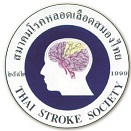Patent foramen ovale related Stroke โรคสมองขาดเลือดที่เกิดจากรูรั่วในผนังกั้นหัวใจห้องบน ชนิดที่เกิดจาก foramen ovale ไม่ปิด
Keywords:
Patent foramen ovale, ischemic stroke, TIAAbstract
The prevalence of patent foramen ovale (PFO) among patients with cryptogenic stroke is 60%. Paradoxical embolism is considered to be the major mechanism of ischemic stroke among patients with patent foramen ovale. Based on previous studies, which did not support the benefit of PFO closure, antiplatelet therapy is recommended for secondary stroke prevention among patients with PFO unless there is an indication for anticoagulant therapy (ie. both PFO and a venous source of embolism). However, three recently published randomized controlled trials have demonstrated the superiority of PFO closure over medical treatment alone. This article reviews current knowledge of PFO regarding prevalence, pathophysiology, diagnosis, and will address the result of recently published clinical trials.
References
Kernan WN, Ovbiagele B, Black HR, et al. Guidelines for the prevention of stroke in patients with stroke and transient ischemic attack: a guideline for healthcare
professionals from the American Heart Association/American Stroke Association. Stroke 2014;45(7):2160-236.
Mas JL, Derumeaux G, Guillon B, et al. Patent Foramen Ovale Closure or Anticoagulation vs. Antiplatelets after Stroke. N Engl J Med 2017;377(11):1011-21.
Søndergaard L, Kasner SE, Rhodes JF, et al. Patent Foramen Ovale Closure or Antiplatelet Therapy for Cryptogenic Stroke. N Engl J Med 2017;377(11):1033-42.
Saver JL, Carroll JD, Thaler DE, Smalling RW, et al. Long-Term Outcomes of Patent Foramen Ovale Closure or Medical Therapy after Stroke. N Engl J Med 2017;377(11);1022-32.
Hara H, Virmani R, Ladich E, et al. Patent foramen ovale: current pathology, pathophysiology, and clinical status. Am J Cardiol 2005;46(9);1769-76.
Desai AJ, Fuller CJ, Jesurum JT, et al. Patent foramen ovale and cerebrovascular diseases. Nat Clin Pract Cardiovasc Med 2006;3:446–55.
Cramer SC, Rordorf G, Maki JH, et al. Increased pelvic vein thrombi in cryptogenic stroke: results of the Paradoxical Emboli from Large Veins in Ischemic Stroke (PELVIS) study. Stroke 2004;35:46–50.
Alsheikh-Ali AA, Thaler DE, Kent DM. Patent foramen ovale in cryptogenic stroke: incidental or pathogenic? Stroke. 2009;40:2349–2355.
Calvet D, Mas JL. Closure of patent foramen ovale in cryptogenic stroke: a never ending story. Curr Opin Neurol 2014;27: 13-19
Schneider B, Zienkiewicz T, Jansen V, et al. Diagnosis of patent foramen ovale by transesophageal echocardiography and correlation with autopsy findings. Am J Cardiol 1996;77:1202–9.
Di Tullio M, Sacco RL, Venketasubramanian N, et al. Comparison of diagnostic techniques for the detection of a patent foramen ovale in stroke patients. Stroke 1993;24:1020–4
Telman G, Yalonetsky S, Kouperberg E, et al. Size of PFO and amount of microembolic signals in patients with ischemic stroke or TIA. Eur J Neurol 2008;15(9):969-972.
Kerut EK, Norfleet WT, Plotnick GD, et al. Patent foramen ovale: A review of associated conditions and the impact of physiological size. J Am Coll Cardiol 2001;38:613-23.
Lao AY, Sharma VK, Tsivgoulis G, Frey JL, Malkoff MD, Navarro JC, Alexandrov AV. Detection of right-to-left shunts: comparison between the International Consensus and Spencer Logarithmic Scale criteria. J Neuroimaging. 2008;18:402–406.
Jauss M, Zanette E. Detection of right-to-left shunt with ultrasound contrast agent and transcranial Doppler sonography. Cerebrovasc Dis 2000;10:490–6..
Telman G, Yalonetsky S, Kouperberg E, et al. Size of PFO and amount of microembolic signals in patients with ischemic stroke or TIA. Eur J Neurol 2008;15(9):969-972.
Spencer MP, Moehring MA, Jesurum J, et al. Power M-mode transcranial Doppler for diagnosis of patent foramen ovale and assessing transcatheter closure. J
Neuroimaging 2004;14:342–9.
Overell JR, Bone I, Lees KR. Interatrial septal abnormalities and stroke: a metaanalysis of case-control studies. Neurology 2000;55:1172–9.
Karttunen V, Hiltunen L, Rasi V, et al. Factor V Leiden and prothrombin gene mutation may predispose to paradoxical embolism in subjects with patent foramen ovale. Blood Coagul Fibrinol 2003;14:261–8
Cotter PE, Martin PJ, Pugh PJ, Warburton EA, Cheriyan J, Belham M. Increased incidence of interatrial block in younger adults with cryptogenic stroke and patent foramen ovale. Cerebrovasc Dis Extra 2011;1:36-43.
Rigatelli G, Aggio S, Cardaioli P, Braggion G, Giordan M, Dell’avvocata F, et al. Left atrial dysfunction in patients with patent foramen ovale and atrial septal aneurysm: an alternative concurrent mechanism for arterial embolism? JACC Cardiovasc Interv 2009;2:655-662.
Kent DM, Ruthazer R, Weimar C, Mas JL, Serena J, Homma S, et al. An index to identify stroke-related vs incidental patent foramen ovale in cryptogenic stroke.
Neurology 2013;81:619-625.
Kent DM, Dahabreh IJ, Ruthazer R, et al. Anticoagulant vs. antiplatelet therapy in patients with cryptogenic stroke and patent foramen ovale: an individual participant data meta-analysis. Eur Heart J 2015;36(35):2381-9.
Furlan AJ, Reisman M, Massaro J, Mauri L, Adams H, Albers GW, et al. Closure or medical therapy for cryptogenic stroke with patent foramen ovale. N Engl J Med 2012;366:991-999.
Carroll JD, Saver JL, Thaler DE, Smalling RW, Berry S, MacDonald LA, et al. Closure of patent foramen ovale versus medical therapy after cryptogenic stroke. N Engl J Med 2013;368: 1092-1100.
Meier B, Kalesan B, Mattle HP, Khattab AA, Hildick-Smith D, Dudek D, et al. Percutaneous closure of patent foramen ovale in cryptogenic embolism. N Engl J Med 2013;368:1083-1091.
แนวทางการรักษาโรคหลอดเลือดสมองตีบหรือ อุดตันสำหรับแพทย์ ฉบับปรับปรุงครั้งที่ 2. 2555.
Downloads
Published
How to Cite
Issue
Section
License
ข้อความภายในบทความที่ตีพิมพ์ในวารสารสมาคมโรคหลอดเลือดสมองไทยเล่มนี้ ตลอดจนความรับผิดชอบด้านเนื้อหาและการตรวจร่างบทความเป็นของผู้นิพนธ์ ไม่เกี่ยวข้องกับกองบรรณาธิการแต่อย่างใด การนำเนื้อหา ข้อความหรือข้อคิดเห็นของบทความไปเผยแพร่ ต้องได้รับอนุญาตจากกองบรรณาธิการอย่างเป็นลายลักษณ์อักษร ผลงานที่ได้รับการตีพิมพ์ในวารสารเล่มนี้ถือเป็นลิขสิทธิ์ของวารสาร





